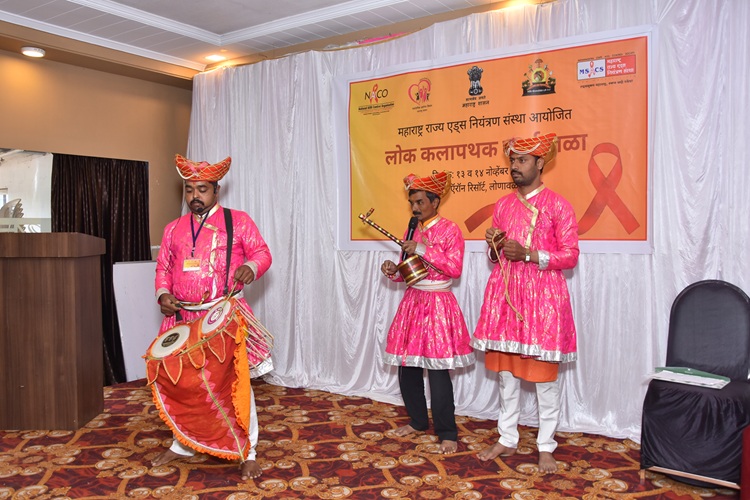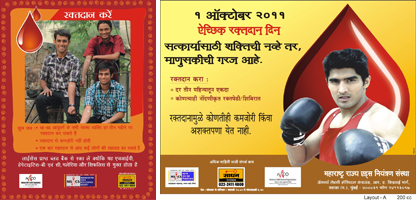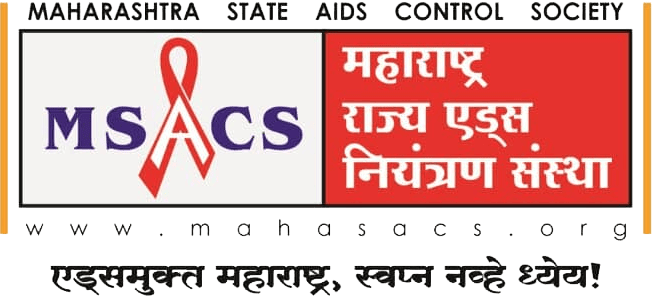Information Education and Communication
BACKGROUND
Maharashtra State AIDS Control Society (MSACS) have used mass media, outdoor campaign and mid media activities to raise awareness among core group, bridge population and general population. Mainstreaming initiatives have been given high priority involving State Rural Health Mission, Health and Family Welfare Department, District Rural Development Agency, Police Department, Self Help Groups and Community leaders etc. This would be further scaled up in the coming years to reach out and sensitize maximum number of people throughout the State to achieve the desired results.
FOCUS AREAS FOR IEC DURING 2024-25
IEC activities during the year 2024-25 have supported the following major components in terms of disseminating the right information to target audiences and also to generate demand through on-ground communication activities, to avail various services like:
- ICTC/PPTCT promotion
- Strengthening linkage services at different levels
- Promotion of pre ART registration and ART services
- Promotion of Blood safety and blood donation
- Promotion of consistent condom use
- Establishing Red Ribbon Clubs
- Implementation of Tribal Action Plan
- Mainstreaming HIV/AIDS
IEC activities have been aligned so as to synchronize with the theme (Blood Safety, PPTCT, ICTC, STI, Condom Promotion, Youth HIV-TB and Stigma & Discrimination) calendar of National AIDS Control Organization (NACO).
This has ensured enabling environment by reinforcing the key messages and facilitated tangible behavior change among intended target audiences.
IEC ACTIVITIES BY MAHARASHTRA STATE AIDS CONTROL SOCIETY
The following IEC components were utilized to carry out activities to spread awareness on HIV prevention, treatment, care and support and ensure effective impact among various target audiences across Maharashtra.
- MASS MEDIA: Major activities were planned by NACO throughout the year, using TV and Radio.


- Television –
-
- Print Media
Newspaper advertisement: Advertisement are being published state wide High circulated newspapers on different themes. Helpline is promoted as part of this campaign and hence it remained as a proxy indicator to evaluate this campaign. In the Month of June STI advertisement has been published.
- OUTDOOR CAMPAIGN:
MSRTC Bus panel:
Temporary Hoardings at S. T. Stands: It is planned to put up temporary hoardings in 13 districts of Maharashtra as per NACO thematic calendar.
- MID MEDIA
Interpersonal communications (IPC): Outreach workers (ORWs) engaged with different target audiences such as Migrants, FSW and MSM have been equipped with periodic training, to carry out the IPC activity. Tools such as “Flipcharts” and leaflets have been utilized to facilitate effective behavior change.
Folk Troupe Campaign
Folk troupe training conducted in Lonavala in the year 2024-25



IEC Material Printing:
A Variety of IEC material have been developed and distributed to all service providers across the state like:
- Printed pamphlets on ICTC, ART, PPTCT, Migrant, truckers, STI




- Printed Flipcharts on PPTCT, ART, STI and distributed to the service providers
- Printed General Information booklets about HIV/AIDS, STI and the services provided by SACS and distributed to all service providers
- Various types of IEC material like ART booklet, flipchart for DIC & CCC, HIV/TB leaflet, condom leaflet are under production
- Exhibition Panels: Exhibition Panels were produced for Blood Safety and Drop in Centers and distributed.

Helpline promotion: Helpline managed by MDACS has been promoted in the IEC component throughout the year across the state. MSACS has supported the operational cost of the promotional campaigns.
Tribal and Mainstreaming Training
Illiteracy, migration and poor access to media makes the tribal population socially vulnerable. With regard to HIV vulnerability, studies have reported that tribal women are particularly vulnerable to HIV/AIDS since they commence sexual activity at an early age. Sexual practices varied widely, sexual relationships out of wedlock are reported to be a very common phenomenon. Girls and boys staying together before marriage is a socially acceptable norm. Couples were also at liberty to divorce and remarry. Males are involved in premarital or extra marital sex. Condoms are generally not used, as these were disliked. The tribal communities are unaware of STIs and HIV/AIDS. Awareness is lower among women.
No specific interventions have started among tribals in the study areas by the government, private or public sector collaborators. Very few NGOs are reported to be working specifically with tribal people on HIV/AIDS. There is a dearth of IEC material communicating in local dialect of tribal people.
Issues covered under Tribal Action Plan
- Integrate tribal and social development issues in the HIV/AIDS programme at every level
- Systematize knowledge management on HIV/AIDS among Tribal people for develop
interventions among them
- Increase access to the range of services under the NACP for tribal areas. Awareness plays a critical role in access of services by the target groups.
- Work with development partners and public and private sector enterprises to
Improve HIV/AIDS prevention and control in tribal people
The total proposed budget for the training workshop under tribal mainstreaming is Rs. 22.98 Lakh which include salary and administration cost. In the state of Maharashtra there are 16 ITDP areas where tribal population is concentrated. As per the Annual Action Plan 2012-2013 Total 72 trainings for the grampanchayat Sarpanch,Non Governmental Organizations representatives,ITDP staff and asharam school Headmasters and Teachers etc.
- Gram Panchayat Sarpanch
- Non Governmental Organizations representative
- Ashram School Heads
- ITDP Stuff Training
Mainstreaming
WHAT IS MAINSTREAMING?
Mainstreaming is recognition of the reality that HIV/AIDS is not just a medical or public health issue, to be left to doctors and scientists. It has both internal and external implications for each and every sector. Mainstreaming is a process that has an impact on and, therefore, necessitates response from all sectors.
Benefits of Mainstreaming
- Reduces large expenditure on health care & social welfare.
- Minimizes negative impact on programmes related to education, livelihood, social welfare, Women and Child Health.
- Saves loss of skilled employees.
Process of Mainstreaming
The process of mainstreaming is divided into two parts – internal and external. The internal mainstreaming is about adapting organizational policies and program in such a way that it reduces organizational susceptibility to HIV. The focus is on staff sensitization and adoption of workplace policies. While external mainstreaming entails using organizational outreach to take the prevention effort to vulnerable groups among the general population. Through Mainstreaming, technical and financial resources of the development partners are leveraged to achieve the desired results.
Widening scope for HIV Mainstreaming
The HIV/AIDS epidemic is emerging as a major challenge to the developing countries as the infection is mainly targeting the productive age group of the population thereby directly affecting the economy & development of the nation. HIV is a manageable chronic disease. Treatment (Anti Retroviral Therapy) to prolong the life of HIV positive persons is available but complete cure is still not available and therefore promoting preventive measures is the only way out to protect ourselves against the virus. To promote the prevention measure there is a need for a multi-sectoral collaboration in order to effectively respond to the epidemic. Mainstreaming and partnerships will be the key approach to facilitate multi-sectoral response engaging a wide range of stakeholders. Private sector, civil society organizations, PLHA networks and government departments are expected to play a crucial role in prevention, care, support, treatment and service delivery. The Various departments covered under Mainstreaming are - Women and Child-addressing specific needs of women and children, adolescents and youth, Panchayat Raj, Rural Development Department, Urban Development Department, Tourism and transport department to spread awareness on different aspects of HIV/AIDS.
However, Stigma & Discrimination in HIV/AID, low levels of literacy, different cultural attitudes and practices regarding sexuality, lack of communication among men and women about their health problems, lack of adequate facilities in health, education etc in rural areas are some of the challenges with regard to HIV/AIDS mainstreaming response.
Benefits of sensitizing women:
- Women will learn to protect themselves more effectively from HIV
- Will help awareness and prevention of HIV
- Will bring about attitudinal change towards the infected /affected
- Will strengthen the bond in the rural community
- Will act as a support for PLHIVs and help reduce Stigma and Discrimination
- Will help eliminate myths and misconceptions about HIV
- Will strengthen the family bond to face HIV crisis in the family
Mainstreaming Trainings:
- Sensitization of SHGs
- Sensitization of Asha workers
- Sensitization of Police personnel
- DIC staff training
- Sensitization of DRDA offs
- Sensitization Students/NSS/RRC members in 3 colleges
- Sensitization of college students
- Sensitization Students/NSS/RRC
- Sensitization of SHGs/AWSs /AWWs/ANMs/ASHAs
- Sensitization of Police personnel
For more information click on following attachments


